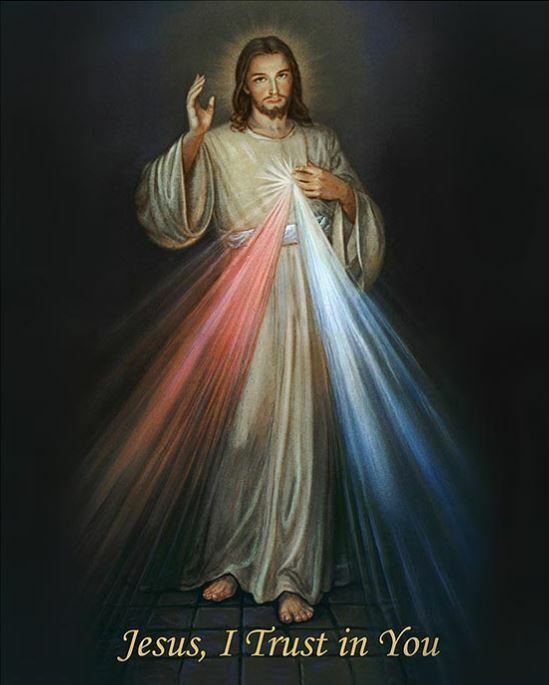 The Divine Mercy Chaplet
The Divine Mercy Chaplet
Jesus appeared to St. Faustina in a vision, with his right hand raised in a blessing and his left touching his garment above his heart. Red and white rays emanate from his heart, symbolizing the blood and water that was poured out for our salvation and our sanctification. The Lord requested that “Jesus, I trust in You” be inscribed under his image. Jesus asked that his image be painted and venerated throughout the world: “I promise that the soul that will venerate this image will not perish” (Diary, no. 48) and “By means of this image I will grant many graces to souls” (Diary, no. 742).
The Chaplet was also given to St. Faustina with this promise: “Encourage souls to say the chaplet which I have given you” (Diary, no. 1541). “Whoever will recite it will receive great mercy at the hour of death. … Even if there were a sinner most hardened, if he were to recite this chaplet only once, he would receive grace from My infinite mercy. I desire that the whole world know My infinite mercy” (Diary, no. 687).
How to pray the Chaplet of Divine Mercy
.png)
Optional Opening Prayers:
You expired, Jesus, but the source of life gushed forth for souls,
and the ocean of mercy opened up for the whole world.
O Fount of Life, unfathomable Divine Mercy,
envelop the whole world and empty Yourself out upon us.
and the ocean of mercy opened up for the whole world.
O Fount of Life, unfathomable Divine Mercy,
envelop the whole world and empty Yourself out upon us.
(Repeat 3 times) O Blood and Water, which gushed forth from the Heart of Jesus as a fountain of Mercy for us, I trust in You!
Our Father, Hail Mary and the Apostle's Creed
For each of the five decades (On each “Our Father” bead of the rosary, pray)
Eternal Father, I offer you the Body and Blood, Soul and Divinity of Your Dearly Beloved Son, Our Lord, Jesus Christ, in atonement for our sins and those of the whole world.
(On each of the 10 “Hail Mary” beads, pray)
For the sake of His sorrowful Passion, have mercy on us and on the whole world.
For the sake of His sorrowful Passion, have mercy on us and on the whole world.
Concluding prayer (Repeat 3 times)
Holy God, Holy Mighty One, Holy Immortal One, have mercy on us and on the whole world.
Holy God, Holy Mighty One, Holy Immortal One, have mercy on us and on the whole world.
Optional Closing Prayer
Eternal God, in whom mercy is endless and the treasury of compassion inexhaustible, look kindly upon us and increase Your mercy in us, that in difficult moments we might not despair nor become despondent, but with great confidence submit ourselves to Your holy will, which is Love and Mercy itself.
Eternal God, in whom mercy is endless and the treasury of compassion inexhaustible, look kindly upon us and increase Your mercy in us, that in difficult moments we might not despair nor become despondent, but with great confidence submit ourselves to Your holy will, which is Love and Mercy itself.
Daily Prayers of the Holy Rosary
We encourage everyone to pray the Rosary and the Divine Mercy Chaplet daily.
Here are guides for the Rosary and the Chaplet:
Monday & Saturday: Joyful Mysteries
Tuesday & Friday: Sorrowful Mysteries
Wednesday & Sunday: Glorious Mysteries
Thursday: Luminous Mysteries
Everyday: Divine Mercy Chaplet
Thank you to all who have been joining us in prayer!
Here are guides for the Rosary and the Chaplet:
Monday & Saturday: Joyful Mysteries
Tuesday & Friday: Sorrowful Mysteries
Wednesday & Sunday: Glorious Mysteries
Thursday: Luminous Mysteries
Everyday: Divine Mercy Chaplet
Thank you to all who have been joining us in prayer!
In addition to these daily prayers, we invite you to pray the Efficacious Novena to the Sacred Heart of Jesus found here.
Want to know more about how you can pray with your Divine Mercy family? Keep reading to see other prayer resources below!
The Rosary
The Rosary is a Scripture-based prayer. It begins with the Apostles' Creed, which summarizes the great mysteries of the Catholic faith. The Our Father, which introduces each mystery, is from the Gospels. The first part of the Hail Mary is the angel's words announcing Christ's birth and Elizabeth's greeting to Mary. St. Pius V officially added the second part of the Hail Mary. The Mysteries of the Rosary center on the events of Christ's life. There are four sets of Mysteries: Joyful, Sorrowful, Glorious and––added by Saint John Paul II in 2002––the Luminous.
The repetition in the Rosary is meant to lead one into restful and contemplative prayer related to each Mystery. The gentle repetition of the words helps us to enter into the silence of our hearts, where Christ's spirit dwells. The Rosary can be said privately or with a group.
How to Pray the Rosary
Make the Sign of the Cross.
Holding the Crucifix, say the Apostles' Creed.
On the first bead, say an Our Father.
Say one Hail Mary on each of the next three beads.
Say the Glory Be
For each of the five decades, announce the Mystery (perhaps followed by a brief reading from Scripture) then say the Our Father.
While fingering each of the ten beads of the decade, next say ten Hail Marys while meditating on the Mystery. Then say a Glory Be. (After finishing each decade, some say the following prayer requested by the Blessed Virgin Mary at Fatima: O my Jesus, forgive us our sins, save us from the fires of hell; lead all souls to Heaven, especially those who have most need of your mercy.)
After saying the five decades, say the Hail, Holy Queen, followed by this dialogue and prayer:
V. Pray for us, O holy Mother of God.
R. That we may be made worthy of the promises of Christ.
Let us pray: O God, whose Only Begotten Son,
by his life, Death, and Resurrection,
has purchased for us the rewards of eternal life,
grant, we beseech thee,
that while meditating on these mysteries
of the most holy Rosary of the Blessed Virgin Mary,
we may imitate what they contain
and obtain what they promise,
through the same Christ our Lord. Amen.
R. That we may be made worthy of the promises of Christ.
Let us pray: O God, whose Only Begotten Son,
by his life, Death, and Resurrection,
has purchased for us the rewards of eternal life,
grant, we beseech thee,
that while meditating on these mysteries
of the most holy Rosary of the Blessed Virgin Mary,
we may imitate what they contain
and obtain what they promise,
through the same Christ our Lord. Amen.
(A prayer to St. Joseph may also follow.) Conclude the Rosary with the Sign of the Cross.
The Mysteries of the Rosary
The Five Joyful Mysteries are traditionally prayed on Mondays, Saturdays, and, during the season of Advent, on Sundays:
-
The Annunciation
- The Visitation
- The Nativity
- The Presentation in the Temple
- The Finding in the Temple
The Five Sorrowful Mysteries are traditionally prayed on Tuesdays, Fridays, and, during the season of Lent, on Sundays:
- The Agony in the Garden
- The Scourging at the Pillar
- The Crowning with Thorns
- The Carrying of the Cross
- The Crucifixion and Death
